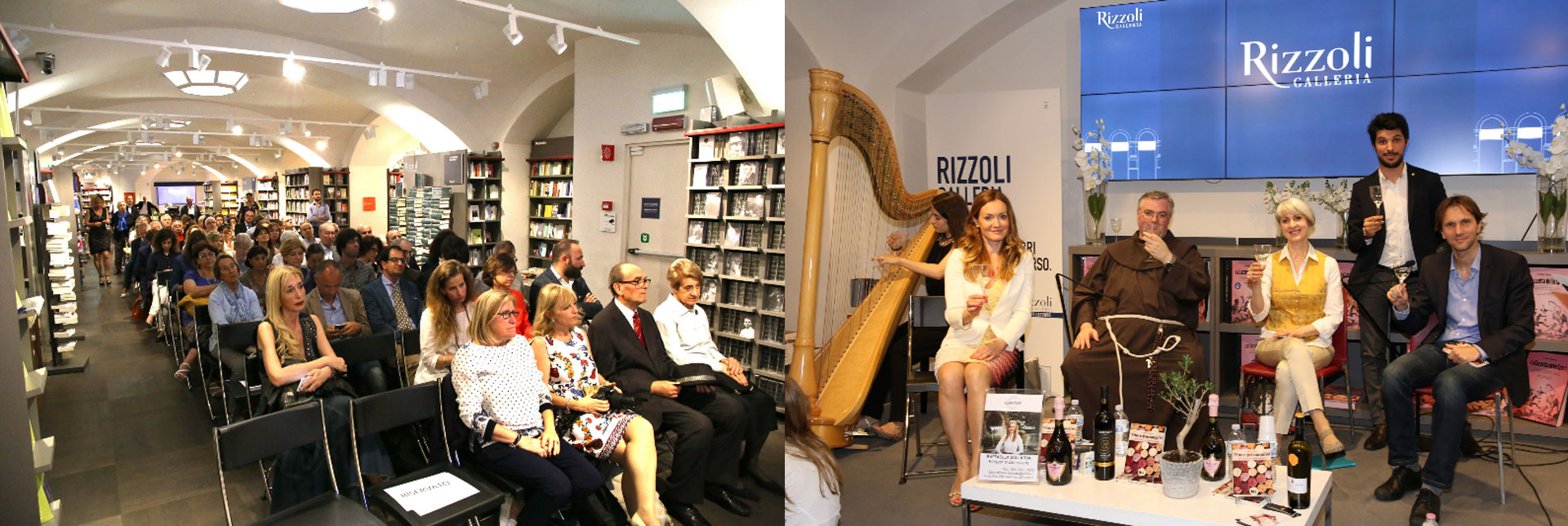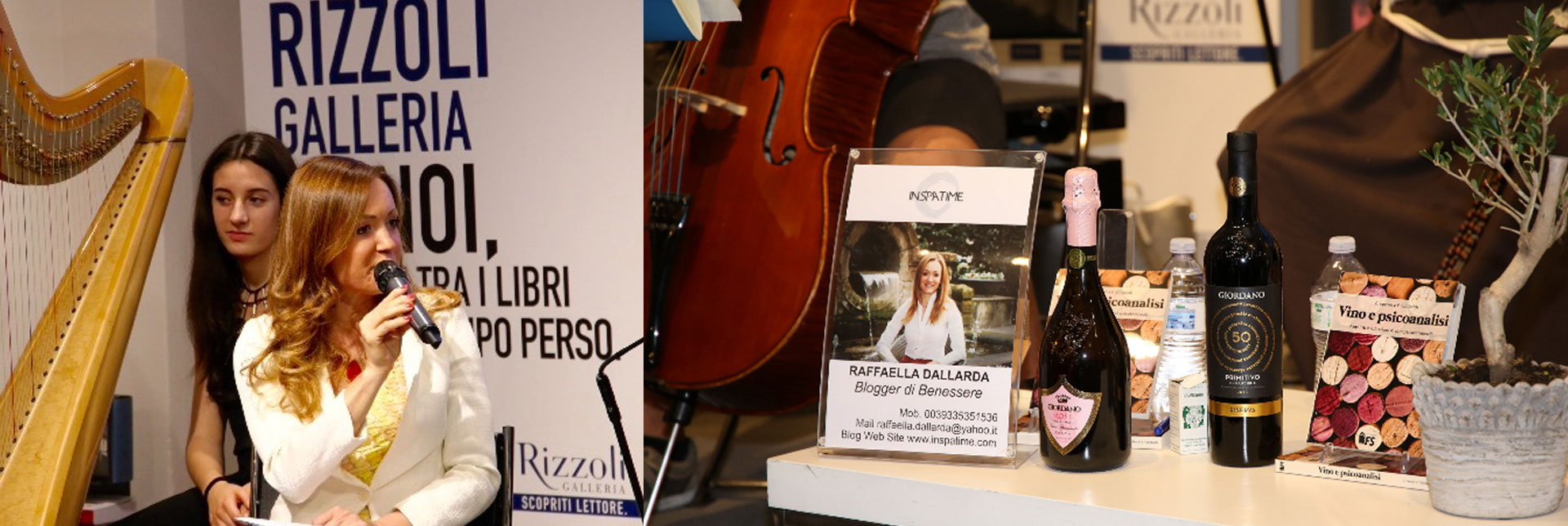
Wellness is tasting wine, pleasure and happiness @Rizzoli Gallery
On Tuesday, June 7th, at the beautiful bookshop lounge of Rizzoli Gallery, the meeting “WELLNESS IS… TASTING WINE, PLEASURE AND HAPPINESS” took place: a flight of fancy through health and emotions. On that occasion the talking was all about the good a nice glass of wine does you.
Moreover, the “nectar of the gods”, as it used to be called in the past, is Italy’s calling card, and tells the story of micro countries and regions. Emotions, sensations, metaphors, the 5 senses – is what you find in a glass of wine.
The event was attended by a number of lecturers: father Luigi Cavagna, biblical scholar, Rector of the Luzzago College in Brescia; SimonaVignali, naturopath and expert in healthy-eating habits; Giuseppe Ferrari, psycho analyst and therapist, author of ” Wine and Psychoanalysis “; Giordano Vini (wine cooperative); and last, but not least, Andrea Matteini, renown sommelier.

In a cosy and warm atmosphere, the singer PatriziaCirulli entertained everybody with music and songs, such as “Vino e D’Annunzio”, “Sotto la luna” and “Barbera e Champagne”, along with a few young musicians: Martina Nifantani and Giovanni Quattrini, who performed with harp and cello.
The Friar Minor presented the traditions behind vine cultivation, bequeathed in the early Middle Ages by the monks, and the many times wine is somewhat symbolised in the Holy Scriptures. From the very beginning, as the book of Genesis recounts it, Noah is remembered as the founder of viticulture and the first who experienced the inebriating effects of wine, thus planting a vineyard. Palestine, as the whole of the Middle East, is a Mediterranean agricultural country, where grapes and wine play an important role on any table; unsurprisingly, the promised land is described as “a land flowing with milk and honey”, a land where wine is plentiful, a sign of fertility, abundance and bliss, therefore a life well lived. Upon the arrival of the Jews, the promised land would become their country, Moses would send a few explorers out ahead and they would return from Mt Hebron with a bunch of grapes.
Wine is definitely superior among all gifts from God, yet symbolising them all, giving nothing but joy to the soul. The abandoned and destroyed vineyard is the right metaphor for God’s judgement, whereby he will “wipe off” the promised land the unfaithful people.
The vine is a plant that needs years to be fruitful, a symbol of a desire to settle down. This is the reason why every ascetic, who does not drink wine, living in teetotalism, does not grow into a sign to fully enjoy salvation. In Babylon and Canaan, the bunch to produce wine was squeezed to death in suffering; after its death wine would come out. Ever since wine has been identified with blood, as well as for its colour, reminding the sacrifices of sacrificial victims.
The prophet Isaiah describes the unique relationship between God and his people in a song called “about the vineyard”, where the word God is translated as my “dearest” or “beloved”. Interestingly, in the Song of Songs the same original term happened to be used for the groom. We also find the same connections with joy, alliance, blood, life and the future kingdom in the New Testament. New wine is the new alliance. Jesus’ first miracle is a landmark example, when he turned water into wine, at the Wedding feast in Cana.
Besides, while on the Cross, he refused wine because he did not want it to numb his senses. Curiously enough, Jesus gave wine to men, as a sign of his suffering, and from men he was offered wine, to ease his pain. By giving his blood, Jesus reopened the doors that lead to the tree of life, since he is the true vine, the true tree of life, as well as in the celebration of the Eucharist.
Undoubtedly, his contribution is very much treasured from within the monastic orders, to the reconstruction of viticulture, in the dark and contradictory years of the Middle Ages, after the economic, spiritual and social fall of the Roman Empire.
Wine is precious for the Church, absolute symbol of the Eucharistic celebration and, in the face of profound poverty, scarce means of transport and very high costs. Needless to say, the most logical and rewarding for the sacred administration was engaging the small monasteries in productive activities, to supply the stocks of the bishops of the time.
We owe it to the hard-working dear friars for the great work, selecting clones and improving cultivation and vinification. They were known as the “fathers of the vineyard” until the eighteenth century, and their work was considered so precious, so much so as to name a “praepositus” after it, that is, an abbot, who was officially assigned the task of looking after the vineyard. Among these, the Benedictine Dom Perignon, in Hauteville.

The commitment of the Cistercians in Burgundy was significant, in those plots of vineyards enclosed by a fence. So, it was to define the earthly life, the “climate”, that combined microclimate and soil, coming out as micro-universes.
For the monks that was way beyond a prestigious life: their attachment to the fruits, traditions, religious needs, to that very nectar, as if it were the Blood of Christ.
The meeting was ended by Father Luigi with a few sayings about wine, such as “to be drinking like a Cappuccin”, that is to drink just a little; “to be drinking like a Celestine”, that is to drink light-heartedly; “to be drinking like a Jacobin”, that is bottle after bottle; “to be drinking like a drawstring” (referring to the Franciscans), that is to drink up the whole cellar! Between the Sacred and the Profane.
Simona Vignaliexplained how wine is good for our body and what amazing potential it has on our health, metabolism and the immune system, as it contains anti-oxidants, flavonoids, polyphenols and anthocyanins, which counteract the aging process, caused by many factors and numerous minerals, vitamins and enzymes, which have proved to be very valuable for our body.
Ideally, two glasses a day would do, ie one every meal. It also represents a natural antidepressant, thanks to the resveratrol in the skin of the grape, which is anti-inflammatory and anticoagulant, helps the memory, lowers cholesterol levels and regulates cardiac activity.
The expert then listed a number of wine infusions, so-called enolites, giving out some recipes, like mulled wine, or wine with citrus – good for your skin, or with eucalyptus – in case you catch cold, Chamomile tea for insomnia, or wine against constipation – as for weight-loss treatments. That shows how alcohol becomes a vehicle for herbs and a natural therapeutic remedy.
Later, Giuseppe Ferrari, psychoanalyst, made mention of some of the contents from his book “Wine and Psychoanalysis”, whereby he compared the understanding of oenology to self-understanding. It’s like the proverb goes “you can tell what somebody is like by the choice of their drink”, either with a wine glass or lying on a bed.
Wine represents inquisitiveness about others, being and sharing with them. When presented along these lines, it does not create any excess or disappointment, as it happens, instead, with the most hazardous consumption of spirits.
As time goes by, we found out that some wines are more cognitive, rational than others. These wines allow a deep introspection of yourself as well as of others. They may be sparkling wines, or champagne, which increase the impulse to experiment relationships with others.
Psychoanalysis is a science that, through the study of conscious or unconscious processes, tries to explain human behaviour. Combined with wine, it embodies the fathomless origin of an eventually explainable culture, because it comes from its own land and from the hands of those, who have cared for it and let it grow. Afterwards, the psychologist read some of his writings, describing the character and behavioural characteristics of various wines, which were later offered as a taste.
Andrea Matteini, Sommelier at Giordano Vini, introduced an interesting symposium, retelling the story of the 100 years of their business, at the foot of the Langhe, along with their tradition. He presented three different wines: red Barbera, Sauvignon blanc and a fizzy Primitivo di Manduria doc, which were later made available for everyone to taste.
The meeting came to an end with a toast “Cheers”, even if Dom Perignon himself was not there. Everyone appreciated what was offered by Verdi Radici e AmoreTerra, who prepared a large banquet with local bio products, along with wines from the wine cooperative Giordano Vinito be consumed with moderation, as to be all sweetness and light!
We also want to thank Giancarlo, official photographer from FotoTorchio Monza.
(Raphaella Dallarda – INSPATIMEBLOG)






